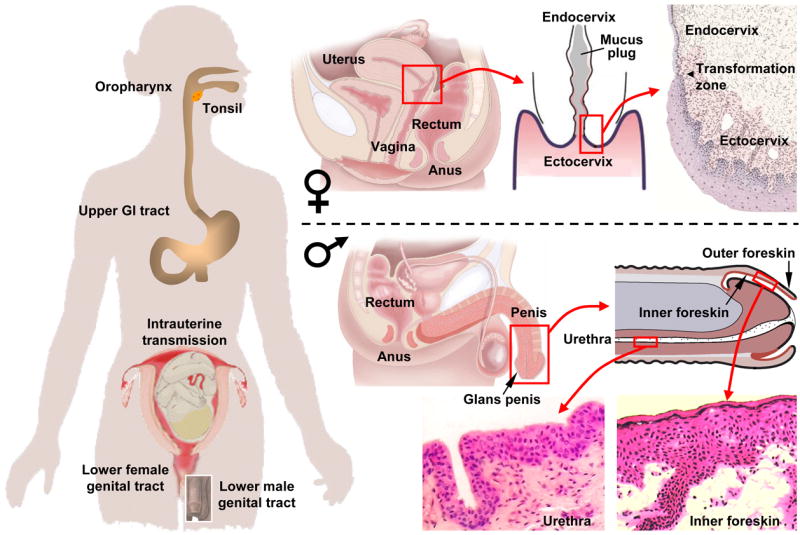Figure 1. HIV invasion sites.

HIV mucosal invasion sites of the lower genital tract, the rectum, and the upper intestinal tract. In women, viral invasion occurs mostly through the non-keratinized squamous epithelium of the vagina and ectocervix, as well as through the single-layer columnar epithelium of the endocervix. The endocervical canal is filled with mucus, providing a barrier against ascent of pathogens. However, ovulation is accompanied by hydration and alkalinization of the mucus plug, possibly decreasing its barrier function. Infection in women can also ensue when HIV-1 invades the single-layer columnar epithelium of the rectum following receptive anal intercourse. In men, viral invasion occurs most frequently through the inner foreskin and the penile urethra as a consequence of penile–vaginal or penile–anal intercourse. Thinly stratified columnar epithelial cells line most of the urethra except for the fossa navicularis near the external meatus (exit hole), which is covered by non-keratinized squamous epithelium. The glans penis and the outer foreskin are protected by keratinized squamous epithelium, which provides a strong mechanical barrier against HIV invasion. By contrast, a thin and poorly keratinized squamous epithelium covers the inner foreskin, rendering this site vulnerable to HIV invasion. Men are also infected by viral invasion through the rectum. In fact, receptive anal intercourse carries the highest per exposure probability of infection among all mucosal transmission sites. The upper gastrointestinal (tract, lined by non-keratinized squamous epithelium in the oropharynx and the esophagus, and by single layer columnar epithelium in the stomach and the small intestine, is another site of mucosal HIV invasion. In adults, transmission in the upper gastrointestinal tract occurs following contact with HIV-containing semen during fellatio, but the efficiency of this route is low. In infants, HIV invasion in the upper gastrointestinal tract occurs after exposure to or ingestion of infected maternal blood and genital secretions during birth as well as infected milk during breast feeding.
